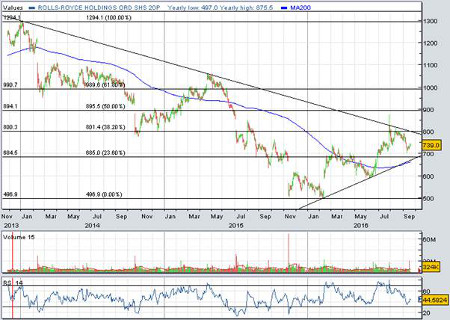Why Rolls-Royce is a 'sell'
20th September 2016 10:59
by Lee Wild from interactive investor
Share on
Half-year results at the end of July put a rocket under share price, which surged by as much as 18% in one trading session. A massive transformation programme is underway designed to slash costs and simplify an impossibly complex business. There is evidence of success here, and annual profits should at least match expectations.
Rolls' shares are off their best levels at 875p post-results, but remain 25% above their early-June low. There's clearly support among investors for one of Britain's best-loved companies, but not everyone in the City is convinced.
"The cost-cutting and strategic priorities identified by the new management do not address the fundamental weakness in its business strategy," argues Sanjay Jha, an analyst at Panmure Gordon. "The seeds for recent profit warnings were sown back in 2011 with the decision to exit narrow-bodies and compete with GE in large engines without any distinctive competitive advantage and a weaker balance sheet."
Next-generation narrow-body aircrafts like the A321neoLR and 787 MAX 8 have extended range and capability. And these plans could be as much as 40% cheaper per trip and 15% cheaper per seat than a twin-aisle aircraft such as A330/B787.

Jha believes that Rolls has missed a trick. Yields are under pressure on most medium-haul routes served by A330-300s, where Rolls has 50% market share, and could easily be replaced with more efficient narrow-body aircrafts. That threatens the cash flows expected from Rolls' growing wide-body installed base.
Budget airlines like Norwegian and Jet Blue are already developing this strategy, which could be in place by March next year – a 737 MAX 8 is planned to fly trans-Atlantic routes for just $69 one-way.
"A bigger threat to wide-bodies will come when Norwegian and JetBlue take delivery of A321LRs from 2019," writes Jha. "This may not only bring forward retirement of older B777s and A330s but may also hurt future sales of A330neo, one of just three large engine platforms now powered by RR."
He's also worried about short-term pressure on higher margin aftermarket revenues, with big customers like Singapore Airlines, American and Lufthansa all reporting a sharp fall in August load factors.
It's not all bad news, though, and there could be an opportunity for Rolls in the narrow-body market if Boeing does launch a replacement for the B757. Rolls will, however, need fresh equity given it takes about £2-2.5 billion to develop a new engine.
"The stock is trading on 28x 2016 [earnings per share] against historical ten-year average of 14.5x, which equates to 500p," writes Jha. That pessimistic price target implies 32% downside from here to the February lows.
This article is for information and discussion purposes only and does not form a recommendation to invest or otherwise. The value of an investment may fall. The investments referred to in this article may not be suitable for all investors, and if in doubt, an investor should seek advice from a qualified investment adviser.